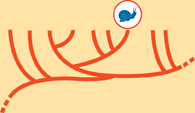Mollusks
KEY CHARACTERISTICS
Mollusks have soft bodies that typically include a muscular foot. Body forms vary greatly. Many mollusks possess a hard shell secreted by the mantle, but in some, the only hard structure is internal. Mollusks are coelomate protostomes with bilateral symmetry.

Feeding and Digestion Digestive system with two openings; diverse feeding styles—mollusks can be herbivores, carnivores, filter feeders, detritivores, or parasites
Circulation Snails and clams—open circulatory system; octopi and squid—closed circulatory system
Respiration Aquatic mollusks—gills inside the mantle cavity; land mollusks—a saclike mantle cavity whose large, moist surface area is lined with blood vessels.
Excretion Body cells release ammonia into the blood, which nephridia remove and release outside the body.
Response Complexity of nervous system varies greatly; extremely simple in clams, but complex in some octopi.
Movement Varies greatly, by group. Some never move as adults, while others are very fast swimmers.
Reproduction Sexual; many aquatic species have free-swimming trochophore larval stage.
• Did You Know?

Colossal Squid
The Colossal Squid
The Colossal Squid, the largest of all mollusks, has the largest eyes of any known animal. One 8-meter-long, 450-kilogram specimen of the species Mesonychoteuthis hamiltoni had eyes 28 centimeters across—larger than most dinner plates! The lens of this huge eye was the size of an orange.
Table of Contents
- Formulas and Equations
- Applying Formulas and Equations
- Mean, Median, and Mode
- Estimation
- Using Measurements in Calculations
- Effects of Measurement Errors
- Accuracy
- Precision
- Comparing Accuracy and Precision
- Significant Figures
- Calculating With Significant Figures
- Scientific Notation
- Calculating With Scientific Notation
- Dimensional Analysis
- Applying Dimensional Analysis




